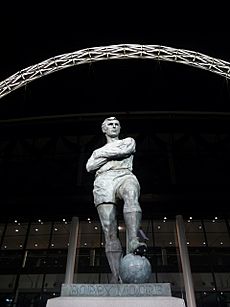Statue of Bobby Moore, Wembley facts for kids

The sculpture in 2008
|
|
| Coordinates | 51°33′26.28″N 0°16′46.56″W / 51.5573000°N 0.2796000°W |
|---|---|
| Location | Wembley Stadium, London |
| Designer | Philip Jackson |
| Type | statue |
| Material | bronze sculpture |
| Height | 20 feet (6.1 m) |
| Beginning date | 2005 |
| Completion date | 2007 |
| Opening date | 11 May 2007 |
The Bobby Moore statue is a large bronze sculpture of the famous English footballer Bobby Moore. You can find it right outside Wembley Stadium in London. This statue celebrates the life of Bobby Moore, who was the captain of the only England team to ever win the FIFA World Cup. They won it in 1966, beating Germany 4–2 at the old Wembley Stadium.
The statue was ordered by the Football Association. It was revealed when the new Wembley Stadium opened in 2007. This was fourteen years after Bobby Moore passed away from cancer at age 51. The sculpture stands 20 feet (6.1 m) tall on a stone base. It looks out over fans as they walk along Wembley Way into the stadium. The artist, Philip Jackson, also created another sculpture of Moore called World Cup Sculpture in 2003.
Contents
About the Statue
This artwork, called The Bobby Moore Sculpture, is made of bronze and is twice the size of a real person. It stands 20 feet (6.1 m) tall, including its base. The statue is placed at the end of Wembley Way and weighs about two tons. It's in a very important spot on the north side of the stadium. Bobby Moore's statue looks north along Wembley Way, watching over all the fans arriving for games.
The front of the statue's stone base has a special plaque. This plaque shows the rest of the 1966 England team. On the side of the base, there's a sculpture of an England football cap. It has the words "World Championship, Jules Rimet Cup, 1970" written on it.
The statue also includes a message written by Jeff Powell, a football writer and close friend of Bobby Moore. It says:
Immaculate footballer. Imperial defender. Immortal hero of 1966. First Englishman to raise the World Cup aloft. Favourite son of London's East End. Finest legend of West Ham United. National Treasure. Master of Wembley. Lord of the game. Captain extraordinary. Gentleman of all time.
Why Bobby Moore?
The statue honors Bobby Moore OBE (1941–1993), a legendary English footballer. Moore was the captain for both West Ham United and the England team. He led England to win the 1966 World Cup at the old Wembley Stadium.
The statue was created to celebrate Moore's amazing achievement as a World Cup-winning England captain. The Football Association decided to commission it after a fan poll. In this poll, fans voted Bobby Moore as the greatest England player of the last 50 years.
The sculptor, Philip Jackson, wanted the statue to show Bobby Moore's best qualities. These included his honesty, loyalty, leadership, popularity, and humble nature. Most importantly, Jackson wanted to show him as the greatest English footballer ever. To design the statue, Jackson talked with a special group. This group included Moore's wife, Stephanie, and his teammates Sir Bobby Charlton, Sir Geoff Hurst, and Sir Trevor Brooking.
How the Statue Was Made
Getting Started
Wembley National Stadium Ltd (WNSL) announced they would order the statue in September 2005. This was while the new Wembley Stadium was being built to replace the Old Wembley. This statue was the first official tribute to Bobby Moore from the Football Association.
Philip Jackson was chosen from a list of artists to create the statue. This was not the first time Jackson had sculpted Moore. He also made The Champions sculpture, which is near West Ham's stadium. That sculpture, revealed in 2003, shows Moore being lifted up by other players while holding the World Cup trophy.
Making the Sculpture
Pictures of the clay model for the sculpture were shared in January 2006. Stephanie Moore, Bobby's wife, visited the studio to see the work as it was being made. First, the sculpture was shaped in clay. Then, a mold was made from hard plaster and sand. This mold was used to cast the statue in bronze. Finally, the bronze statue was treated to give it its finished color.
Jackson even made eight copies of Moore's right foot for the sculpture. One of these was sold at an auction in May 2006. The money raised went to Moore's cancer charity.
The Unveiling
The statue was officially revealed on May 11, 2007. Sir Bobby Charlton did the honors. Guests at the event included Moore's wife Stephanie, Prime Minister Tony Blair, and Sir Geoff Hurst. The statue was the "finishing touch" for the new Wembley Stadium. The stadium officially opened on May 19, 2007, with the 2007 FA Cup Final.
Images for kids








